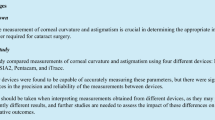Abstract
Purpose
The purpose of the study was to assess the agreement of anterior segment optical coherence tomography with its older well-known opponent i.e., Sheimpflug imaging in evaluation of the cornea in normal and keratoconus subjects.
Methods
107 normal and 56 keratoconus eyes were evaluated with the anterior segment optical coherence tomography followed by the Scheimpflug imaging. Parameters included axial keratometry data in both of steep and flat meridians, mean keratometry and the astigmatism values in the central 4.0 mm zone, central, thinnest and apex corneal thicknesses, Q-value in 8 mm zone and pupil diameter. Corneal topographic maps were recorded and were evaluated for anterior highest and lowest points, posterior highest and lowest points. Average values were recorded for analysis.
Results
All anterior cornea keratometry indices showed perfect agreement between two devices in normal corneas; while the level of agreement in keratoconus cases ranged from moderate to strong. All posterior keratometry indices also showed perfect agreement in both groups; except for flat K in normal corneas and steep K in KC ones. The amount of corneal cylinder in normal corneas had perfect agreement, and moderate to strong agreement in anterior/posterior cornea in keratoconus group. Anterior highest and lowest points showed strong and perfect agreement in normal and keratoconus cases, respectively. Posterior highest and lowest points showed strong agreement in normal cases. Thickness indices (central, thinnest, and apex thicknesses) showed perfect agreement between two devices in both normal and KC groups. Mean values of anterior and posterior highest points were statistically higher in Scheimpflug system.
Conclusions
Although two imaging technologies had statistically numerical different output, it seems that they have a good agreement in most parameters.






Similar content being viewed by others
References
Piñero DP (2015) Technologies for anatomical and geometric characterization of the corneal structure and anterior segment: a review. Semin Ophthalmol 30(3):161–170
Cavas-Martínez F, De la Cruz Sánchez E, Nieto Martínez J, Fernández Cañavate FJ, Fernández-Pacheco DG (2016) Corneal topography in keratoconus: state of the art. Eye Vis (Lond) 3:5
Ziaei M, Barsam A, Shamie N, Vroman D, Kim T, Donnenfeld ED, Committee ACC (2015) Reshaping procedures for the surgical management of corneal ectasia. J Cataract Refract Surg 41(4):842–872
Matalia H, Swarup R (2013) Imaging modalities in keratoconus. Indian J Ophthalmol 61(8):394–400
Nakagawa T, Maeda N, Higashiura R, Hori Y, Inoue T, Nishida K (2011) Corneal topographic analysis in patients with keratoconus using 3-dimensional anterior segment optical coherence tomography. J Cataract Refract Surg 37(10):1871–1878
Fukuda S, Beheregaray S, Hoshi S, Yamanari M, Lim Y, Hiraoka T, Oshika T (2013) Comparison of three-dimensional optical coherence tomography and combining a rotating Scheimpflug camera with a Placido topography system for forme fruste keratoconus diagnosis. Br J Ophthalmol 97(12):1554–1559
Lee YW, Choi CY, Yoon GY (2015) Comparison of dual rotating Scheimpflug-Placido, swept-source optical coherence tomography, and Placido-scanning-slit systems. J Cataract Refract Surg 41(5):1018–1029
Szalai E, Berta A, Hassan Z, Módis L (2012) Reliability and repeatability of swept-source Fourier-domain optical coherence tomography and Scheimpflug imaging in keratoconus. J Cataract Refract Surg 38(3):485–494
Huang J, Feng Y, Wang Q, Pesudovs K (2012) Assessment of corneal thickness measurement using swept-source Fourier-domain anterior segment optical coherence tomography and Scheimpflug camera. J Cataract Refract Surg 38(7):1305–1306
Ishibazawa A, Igarashi S, Hanada K, Nagaoka T, Ishiko S, Ito H, Yoshida A (2011) Central corneal thickness measurements with Fourier-domain optical coherence tomography versus ultrasonic pachymetry and rotating Scheimpflug camera. Cornea 30(6):615–619
Fu J, Wang X, Li S, Wu G, Wang N (2010) Comparative study of anterior segment measurement with Pentacam and anterior segment optical coherence tomography. Can J Ophthalmol 45(6):627–631
Wang Q, Ding X, Savini G, Chen H, Feng Y, Pan C, Hua Y, Huang J (2015) Anterior chamber depth measurements using Scheimpflug imaging and optical coherence tomography: repeatability, reproducibility, and agreement. J Cataract Refract Surg 41(1):178–185
Nakakura S, Mori E, Nagatomi N, Tabuchi H, Kiuchi Y (2012) Comparison of anterior chamber depth measurements by 3-dimensional optical coherence tomography, partial coherence interferometry biometry, Scheimpflug rotating camera imaging, and ultrasound biomicroscopy. J Cataract Refract Surg 38(7):1207–1213
Shammas HJ, Ortiz S, Shammas MC, Kim SH, Chong C (2016) Biometry measurements using a new large-coherence-length swept-source optical coherence tomographer. J Cataract Refract Surg 42(1):50–61
Wang M, Corpuz CC, Huseynova T, Tomita M (2016) Pupil influence on the visual outcomes of a new-generation multifocal toric intraocular lens with a surface-embedded near segment. J Refract Surg 32(2):90–95
Heine C, Yazdani F, Wilhelm H (2013) Pupillary diameter in every day situations. Klin Monbl Augenheilkd 230(11):1114–1118
Chan TC, Biswas S, Yu M, Jhanji V (2015) Longitudinal evaluation of cornea with swept-source optical coherence tomography and Scheimpflug imaging before and after lasik. Medicine (Baltimore) 94(30):e1219
Acknowledgments
This study was supported by Isfahan University of Medical Sciences.
Author information
Authors and Affiliations
Corresponding author
Rights and permissions
About this article
Cite this article
Ghoreishi, S.M., Mortazavi, S.A.A., Abtahi, ZA. et al. Comparison of Scheimpflug and swept-source anterior segment optical coherence tomography in normal and keratoconus eyes. Int Ophthalmol 37, 965–971 (2017). https://doi.org/10.1007/s10792-016-0347-8
Received:
Accepted:
Published:
Issue Date:
DOI: https://doi.org/10.1007/s10792-016-0347-8




